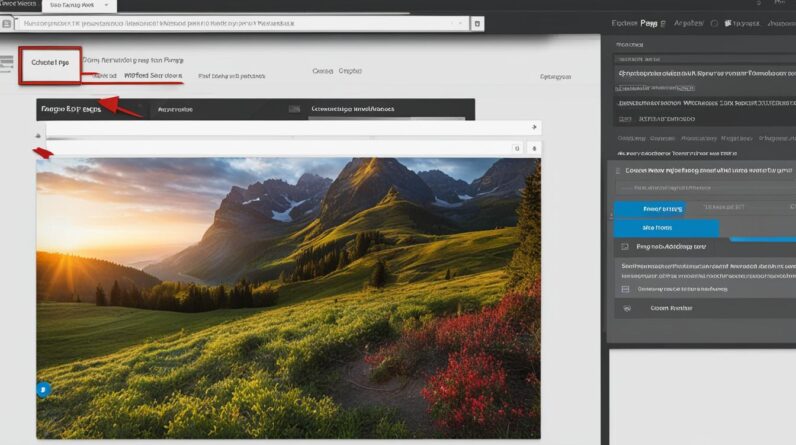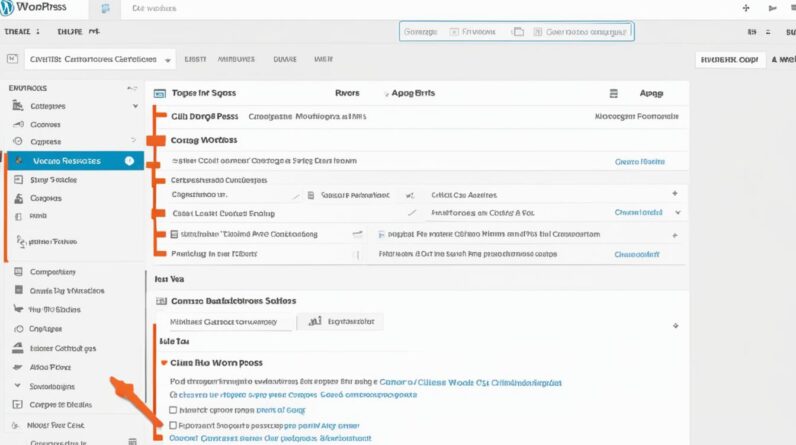Changing your website’s domain name is a decision that requires careful consideration, especially if you have an established WordPress site. But fear not, with the right guidance, the process can be smooth and hassle-free. In this article, I will provide you with a quick and comprehensive guide on how to change your WordPress domain, ensuring a successful transition.
How to Make Money with YouTube
Create an empire of automated video websites for multiple streams of income
Key Takeaways:
- Changing your WordPress domain name can have advantages and disadvantages.
- There are several reasons why you might want to change your domain name.
- Purchasing a new domain name is necessary to change your domain.
- Changing your domain name in WordPress requires adjustments in settings and files.
- Proper preparation, backup, and communication are crucial for a smooth domain change.
Why Would You Want to Change Your Domain Name?
There are several reasons why you might consider changing your domain name. Whether you are rebranding your business, adjusting your business name, or aiming to change your domain extension, changing your domain name can bring numerous benefits and opportunities.
- Brand Alignment: Changing your domain name allows you to align your website more effectively with your brand. A domain name that reflects your business name or core values can create a stronger connection with your audience and enhance brand recognition.
- Improved Discoverability: A domain name change can make it easier for customers to find your website. By selecting a domain name that includes relevant keywords or is more intuitive, you can increase your website’s visibility in search engine results and attract targeted traffic.
- Rebranding and Expansion: Are you undergoing a rebranding process or expanding your business into new markets? Changing your domain name allows you to match your new brand identity or target specific audiences.
- Enhanced Credibility: A domain name that is concise, memorable, and professional can enhance your credibility and the perceived value of your brand. It can create a positive first impression and instill trust in your audience.
- Strategic Differentiation: Changing your domain name presents an opportunity to differentiate yourself from competitors. Whether it’s through creative spelling, new keywords, or a unique domain extension, you can stand out in a crowded digital landscape.
In conclusion, changing your domain name can offer several advantages, including brand alignment, improved discoverability, rebranding opportunities, enhanced credibility, and strategic differentiation. However, it’s crucial to plan and execute the transition carefully to ensure a seamless experience for your audience.
Do You Have to Purchase a New Domain Name?
When it comes to changing your domain name, purchasing a new one is a necessary step in the process. By acquiring a new domain name, you can ensure a seamless transition and maintain your online presence without any interruptions.
There are several domain name registrars where you can purchase a new domain name. These registrars offer a variety of options and extensions to choose from, allowing you to find the perfect domain that aligns with your brand. Take the time to research and select a domain name that is effective, memorable, and reflects your business or website.
To give you a clearer understanding of the domain purchasing process, here is a step-by-step guide:
- Research domain registrars: Start by exploring different domain registrars and comparing their prices, features, and customer reviews. Some popular domain registrars include GoDaddy, Namecheap, and Google Domains.
- Check domain availability: Once you have identified a domain registrar, use their search tool to check if your desired domain name is available. If it is already taken, the registrar may suggest alternative options or variations.
- Choose the domain extension: Select the domain extension that suits your website the best. The most common domain extensions are .com, .net, and .org, but there are also industry-specific extensions like .photography or .tech.
- Complete the registration process: Provide the necessary information to register your new domain. This typically includes your contact details and payment information. Make sure to double-check all the information before proceeding with the purchase.
- Domain setup: Once you have purchased your new domain, you will need to set it up to work with your website hosting provider. This involves updating the domain’s nameservers or configuring DNS settings. If you’re not familiar with this process, consult your hosting provider’s support documentation or reach out to their customer service for assistance.
It’s important to note that during the domain transition, it is recommended to keep both domains active for at least six months. This allows you to redirect visitors from your old domain to the new one and ensures a smooth user experience. Make sure to set up proper redirects to guide your audience to the correct address.
Here is an example of how you can redirect visitors from your old domain to the new one using an htaccess file:
RewriteEngine on
RewriteCond %{HTTP_HOST} ^old-domain\.com$ [NC,OR]
RewriteCond %{HTTP_HOST} ^www.old-domain\.com$
RewriteRule ^(.*)$ http://www.new-domain.com/$1 [L,R=301]By purchasing a new domain name, you are taking the necessary steps to ensure a successful domain change. Remember to choose a domain that reflects your brand, set up proper redirects, and provide a seamless transition for your website visitors.
How Do You Change Your Domain Name in WordPress?
Changing your domain name in WordPress involves adjusting some settings in two different places. First, you need to change your URL within the WordPress dashboard by navigating to the Settings > General screen. Then, you need to update the wp-config.php file or wp config file to reflect the changes. It is also important to check that the domain change has been correctly implemented.
Step 1: Change Your URL Within WordPress
To change your URL within WordPress, follow these steps:
- Login to your WordPress dashboard.
- Navigate to the Settings > General screen.
- Locate the “WordPress Address (URL)” and “Site Address (URL)” fields.
- Update both fields with your new domain name.
- Click the “Save Changes” button.
| Steps to Change Your URL in WordPress |
|---|
| Step 1: Login to your WordPress dashboard |
| Step 2: Navigate to the Settings > General screen |
| Step 3: Locate the “WordPress Address (URL)” and “Site Address (URL)” fields |
| Step 4: Update both fields with your new domain name |
| Step 5: Click the “Save Changes” button |
Step 2: Update the wp-config.php File
After changing your URL within WordPress, you need to update the wp-config.php file or wp config file. This step ensures that WordPress recognizes your new domain name. Follow these steps to update the wp-config.php file:
- Access your website’s files using an FTP client or a file manager in your hosting control panel.
- Search for the wp-config.php file in the root directory of your WordPress installation.
- Download a backup of the wp-config.php file as a precaution.
- Edit the wp-config.php file using a text editor.
- Locate the line that defines the
WP_SITEURLandWP_HOMEconstants. - Replace the old domain name with your new domain name.
- Save the changes and upload the modified wp-config.php file back to your server.
Note: Modifying the wp-config.php file requires caution and technical knowledge. Make sure to have a backup of the file and consider seeking assistance if needed.
After updating the wp-config.php file, it is important to verify that the domain change has been correctly implemented. Check your website’s front-end and back-end to ensure that all links and functionality are working as expected.
Step 1: Change Your URL Within WordPress
To change your URL within WordPress, follow these simple steps:
- Log into your WordPress dashboard.
- Navigate to the Settings menu and select General.
- In the General Settings screen, you will see the WordPress Address (URL) and Site Address (URL) fields.
- Enter your new domain name in both fields, including the desired protocol (HTTP or HTTPS).
- Save your changes by clicking the Save Changes button at the bottom of the page.
Once you have saved your changes, your site’s back end will be temporarily inaccessible until you complete the rest of the domain change process.
It’s important to note that changing your URL within WordPress is just the first step in the process of updating your domain name. In the next step, you’ll need to set up permanent redirects and notify search engines of the change, which we’ll cover in the following section.
Step 2: Set Up Permanent Redirects and Notify Search Engines of the Change
In order to ensure a smooth transition from your old domain to the new one, it is crucial to set up permanent redirects. This will redirect visitors from your old domain to the corresponding pages on your new domain. Additionally, it is important to notify search engines, particularly Google, of the domain change to update their indexing.
To set up permanent redirects, you need to add code to the .htaccess file in your hosting control panel. This file controls the server’s behavior and can be accessed through an FTP client or the file manager provided by your hosting provider.
Here’s an example of the code you can add to your .htaccess file to set up a permanent redirect:
RewriteEngine on
RewriteRule ^(.*)$ http://www.newdomain.com/$1 [R=301,L]
Replace “newdomain.com” with your new domain name, and make sure to include the “http://” or “https://” prefix if applicable.
Once you have added the code to the .htaccess file, save the changes. The permanent redirect will now be in effect, directing visitors to your new domain.
Next, it is important to notify search engines of the domain change. This ensures that they update their index and reflect the new domain in their search results. One effective way to notify search engines is by using the Change of Address tool in Google Search Console.
To notify Google of the domain change, follow these steps:
- Log in to your Google Search Console account.
- Select your website property.
- Navigate to the “Settings” section and choose “Change of Address.”
- Choose the new domain from the drop-down menu and click “Submit.”
- Verify the ownership of the new domain in Google Search Console if you haven’t already done so.
By using the Change of Address tool, you are notifying Google of the domain change and helping them update their index accordingly.
Remember, setting up permanent redirects and notifying search engines are vital steps to ensure a seamless transition and prevent any loss of traffic or search rankings. By following these steps, you can successfully redirect your visitors to your new domain and keep search engines informed of the change.
Preparing for the Domain Change
Before changing your domain name, it is crucial to make the necessary preparations. This will ensure a smooth transition and minimize any potential issues. Here are the key steps to take:
1. Create a Full Backup of Your Website
Backing up your website is an essential precautionary measure before making any changes. It will safeguard your valuable content and allow you to restore your site in case anything goes wrong during the domain change process. There are various plugins available that can help you easily backup your website, such as UpdraftPlus and VaultPress. Make sure to follow the plugin instructions to create a comprehensive backup.
| Website Backup Plugins |
|---|
| UpdraftPlus |
| VaultPress |
2. Use an FTP Client to Access Your Server
An FTP client allows you to connect to your server and manage files and folders. It is beneficial when it comes to uploading and modifying files during the domain change process. Popular FTP clients include FileZilla, Cyberduck, and WinSCP. Before proceeding with the domain change, ensure that you have an FTP client installed on your computer and have the necessary login credentials to access your server.
3. Have Your Server Credentials Ready
In order to make changes to your server settings, you will need your server credentials. This typically includes your FTP username and password, as well as your hosting control panel login information. Keep these credentials readily available, as you will need them at various stages of the domain change process.
4. Prepare Your Custom Domain Name
Before initiating the domain change, it is recommended to already have a custom domain name purchased and ready for pointing. This means that you have already registered and configured your new domain name with a domain registrar. Make sure to choose a domain name that aligns with your brand and reflects your website’s purpose.
Choosing a New Domain Name
When it comes to choosing a new domain name, there are a few important factors to consider. First and foremost, you’ll need to use a domain registrar to reserve and purchase your desired domain name. A domain registrar is a company that manages the reservation of internet domain names.
There are plenty of domain registrars available online, offering a wide range of services and pricing options. Some popular domain registrars include GoDaddy, Bluehost, and Namecheap. These platforms provide user-friendly interfaces and comprehensive domain management features.
Additionally, some hosting services even offer free domains when you sign up for their hosting plans. This can be a great option if you’re just starting out or on a tight budget. However, it’s important to note that free domains often come with limitations and may not offer the same level of customization or branding opportunities as a paid domain.
When choosing a new domain name, it’s crucial to select a name that is unique and reflects your brand. Your domain name is the online identity of your website, so it should be memorable, relevant, and easy to spell. Consider using keywords related to your industry or niche to optimize your website’s search engine visibility.
Key Points:
- Choose a domain registrar to reserve and purchase your desired domain name.
- Consider popular domain registrars like GoDaddy, Bluehost, and Namecheap.
- Some hosting services offer free domains, but they may have limitations.
- Select a domain name that is unique, memorable, and reflects your brand.
Backing Up Your Website
Before making any changes to your domain name, it is crucial to back up your website to safeguard your content. This step is important in case something goes wrong during the domain change process. Fortunately, there are plugins available that can help you easily perform website backups.
The Importance of Website Backup
Website backup is essential to protect your valuable content and ensure its safety. By regularly backing up your website, you can avoid losing data due to technical issues, accidental deletions, or security breaches. Having a recent backup of your website guarantees that you can quickly restore your content if any unforeseen problems occur during the domain change process.
Choosing the Right Backup Plugin
When it comes to backing up your website, choosing the right plugin can make the process simple and efficient. There are numerous backup plugins available for WordPress that offer various features, including automatic scheduling, incremental backups, and remote storage options. Some popular backup plugins include:
- UpdraftPlus: This plugin is highly recommended for its flexibility and ease of use. It allows you to schedule backups and store them in multiple destinations, such as cloud storage services like Dropbox, Google Drive, or Amazon S3.
- BackupBuddy: Known for its robust backup capabilities, BackupBuddy offers features like website migration, malware scanning, and restoration options.
- WPvivid Backup Plugin: WPvivid provides a user-friendly interface and offers features like full backups, incremental backups, and one-click restoration.
Before selecting a backup plugin, carefully consider your specific needs and preferences. Read reviews and compare the features available to ensure you choose a plugin that suits your requirements.
By backing up your website before changing your domain name, you can have peace of mind knowing that your valuable content is secure. Remember, taking this precautionary step can save you from potential data loss and help ensure a smooth transition to your new domain.
Notifying Your Audience
Once you have chosen your new domain name, it is crucial to inform your audience about the upcoming changes. This ensures that they are aware of the transition and can access your content without any disruptions. Here are some steps you can take to effectively notify your audience:
- Announcement: Begin by making an announcement on your website or blog, clearly stating that a domain change is imminent.
- Timeline: Provide a timeline for the domain change, specifying when the new domain will be live. This gives your audience an expectation of when they should start accessing your content using the new domain.
- Communication Channels: Utilize various communication channels to reach your audience, such as email newsletters, social media platforms, and any other platforms where you interact with your audience regularly.
- Benefits: Highlight the benefits of the domain change for your audience. Assure them that the new domain will enhance their user experience, making it easier for them to find and engage with your content.
- Access: Reassure your audience that they will still be able to access your content during and after the domain change. Explain that the existing URLs will be redirected to the new domain, ensuring a seamless transition.
- Support: Provide contact information or support channels for your audience to reach out to in case they encounter any issues or have questions regarding the domain change.
Example Announcement:
Dear valued readers,
I am excited to announce that we will be changing our domain name to better align with our brand and enhance your experience. Starting from [date], our website will be accessible through the new domain [new domain name].
We understand the importance of a seamless transition, and we want to assure you that during the domain change process, you will still have full access to all our content. Your bookmarked links and saved pages will automatically redirect to the corresponding pages on the new domain, so you won’t miss out on any of our valuable resources.
We will keep you updated throughout the process and provide any necessary instructions or support. If you have any questions or concerns, please don’t hesitate to reach out to us at [email address] or through our social media channels.
We appreciate your continued support and look forward to delivering even more valuable content on our new domain. Thank you for being a part of our community!
Best regards,
[Your Name]
WordPress Change Domain Plugins
If you’re planning to change your domain name in WordPress, there are several plugins available to make the process easier and more efficient. These plugins can assist you with tasks such as backing up your website, redirecting URLs, and handling the domain change process seamlessly. Here are some popular WordPress plugins that can help you in this endeavor:
Duplicator
Duplicator is a powerful plugin that allows you to easily backup and migrate your WordPress site. It provides a straightforward process for duplicating your entire website, including all files, databases, plugins, and themes. With Duplicator, you can create a snapshot of your site and then restore it on the new domain with just a few clicks.
Redirection
The Redirection plugin is a useful tool for redirecting URLs while changing your domain name. It allows you to set up 301 redirects, which inform search engines and visitors that your old URLs have permanently moved to new locations. This plugin ensures that your website traffic seamlessly transitions to the new domain, preserving your SEO efforts and user experience.
Backup Guard
Backup Guard is a comprehensive backup plugin that provides an easy and reliable way to backup, restore, and migrate your WordPress site. With this plugin, you can create both full and partial backups of your website’s files and database. It also offers migration functionality, allowing you to move your site to a new domain effortlessly.
These WordPress plugins for domain change offer a range of functionalities that can simplify the process and ensure a smooth transition to your new domain. Whether you need to backup your website, set up redirects, or migrate your content, these plugins have got you covered.

By utilizing the right combination of plugins and following the necessary steps outlined in this guide, you can successfully change your WordPress domain name without any hassle or disruptions to your site’s performance.
Conclusion
Changing your WordPress domain name can be a complex process, but with careful planning and the right tools, it can be done successfully. It is crucial to consider the reasons for changing your domain name and ensure that you have purchased a new domain that reflects your brand. Following the necessary steps within the WordPress platform is essential for a smooth transition.
By taking the time to understand the process and following the instructions in this guide, you can minimize potential disruptions to your website and maintain your online presence. Remember to back up your website before making any changes and notify your audience to ensure a seamless transition. Clear communication with your visitors is key.
Changing your domain name may have long-term benefits for your business, such as aligning your website with your brand and making it easier for customers to find you. However, it is important to evaluate the impact and potential risks before proceeding. With the right approach, changing your WordPress domain can lead to a fresh start and improved online visibility.
FAQ
Why would you want to change your domain name?
There are several reasons why you might want to change your domain name, including changing your business name, rebranding, or wanting to change your domain extension. Changing your domain name can make it easier for customers to find you and align your website with your brand.
Do you have to purchase a new domain name?
Yes, in order to change your domain name, you will need to purchase a new domain name. This can be done through a domain name registrar. It is important to choose an effective and available domain name that reflects your brand. Additionally, it is recommended to have both domains for at least six months to redirect visitors from your old address to the new one.
How do you change your domain name in WordPress?
Changing your domain name in WordPress involves adjusting some settings in two different places. First, you need to change your URL within the WordPress dashboard by navigating to the Settings > General screen. Then, you need to update the wp-config.php file or wp config file to reflect the changes. It is also important to check that the domain change has been correctly implemented.
Step 1: How do you change your URL within WordPress?
To change your URL within WordPress, log into your WordPress dashboard and go to the Settings > General screen. In this screen, you can change the WordPress Address and Site Address to your new domain name. It is important to note that once you save your changes, your site’s back end will be temporarily inaccessible until you complete the rest of the process.
Step 2: How do you set up permanent redirects and notify search engines of the change?
In order to ensure that visitors are redirected from your old domain to your new one, you need to set up permanent redirects. This can be done by adding code to the .htaccess file in your hosting control panel. Additionally, you should notify search engines, particularly Google, of the change using the Change of Address tool in Google Search Console.
How do you prepare for the domain change?
Before changing your domain name, it is important to make some preparations. These include creating a full backup of your website, using a File Transfer Protocol (FTP) client to access your server, and having your server credentials ready. It is also recommended to already have a custom domain name purchased and ready for pointing.
How do you choose a new domain name?
When choosing a new domain name, you can use a domain registrar to reserve and purchase your desired domain name. There are plenty of domain registrars available online, and some hosting services even offer free domains. It is important to choose a domain name that is unique and reflects your brand.
How do you back up your website?
Before making any changes to your domain name, it is crucial to back up your website to safeguard your content. There are plugins available that can help you easily back up your website. This step is important in case something goes wrong during the domain change process.
How do you notify your audience of the domain change?
Once you have chosen your new domain name, it is important to notify your audience of the upcoming changes. Let them know when they can expect to see the new domain and reassure them that they will still be able to access your content. Clear communication with your audience is key during the domain change process.
Are there any WordPress plugins available to assist with the domain change process?
There are several plugins available that can assist you with backing up your website, redirecting URLs, and handling the domain change process. Some popular options include Duplicator, Redirection, and Backup Guard. These plugins provide functionalities such as easy backup, 301 redirects, and migration assistance.
Can changing your WordPress domain name be a complex process?
Changing your WordPress domain name can be a complex process, but with careful planning and the right tools, it can be done successfully. It is important to consider the reasons for changing your domain name, purchase a new domain, and follow the necessary steps within WordPress. By following this guide, you can ensure a smooth transition to your new domain name.






